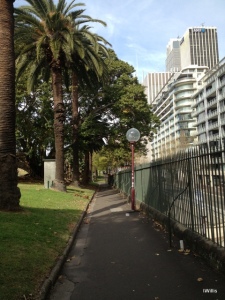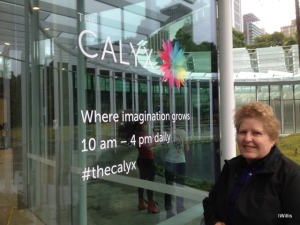2023 Australian Institute of Landscape Architects Award
One of the newest facilities at the Australian Botanic Gardens Mount Annan, the National Herbarium of New South Wales, has won a top architecture award.
The AILA has awarded the design of the National Herbarium of NSW the AILA 2023 NSW Australian Institute of Landscape Architects Awards in the category of Health & Education.
Designed by Australian architects and design studio Architectus the building was inspired by the seed pod of the waratah, the floral symbol of NSW.

The citation for the award states:
The landscape design expresses a unique perspective of the nature of an herbarium: this place is not only dedicated to researching the science of plants and their ecosystems, but also making this knowledge accessible to the community. In a fluid and bespoke language, the design makes use of the site’s microclimates and topography to imbue ecosystems diversity and experiential richness with an holistic clarity. It beautifully dissembles the institution’s scientific remit to encourage visitor awareness of plants, ecology, and landscape.
https://aila.awardsplatform.com/gallery/nbaZWrEE/YqRZlowG?search=8a05d209e52fb180-20

Opening in 2022, the AILA website states:
The National Herbarium of NSW houses more than 1.1 million plant specimens. Lacking the requisite environmental controls to maintain the collection and outgrowing its historic location, the Herbarium relocated to the Australian Botanic Gardens Mount Annan. With deep insulated walls protecting and preserving valuable plant specimens for future generations. Complementing the building’s aspirations, a bespoke landscape showcases significant and meaningful plants from the collection in living form. Reinforcing connection to Country, this offers a place for reconciliation and gathering and a celebration and living showcase of the collection’s diversity.
https://aila.awardsplatform.com/gallery/nbaZWrEE/YqRZlowG?search=8a05d209e52fb180-20
Problems at the herbarium at Royal Botanic Gardens Sydney
Before relocating the National Herbarium to the ABG Mount Annan, the plant collection was located in the Robert Brown building at the Royal Botanic Gardens Sydney. The collection faced several issues, including pest control.

The National Herbarium website states that the existing Robert Brown Building at the RBG Sydney was constructed in 1982.
The website continues:
the Herbarium’s storage capacity in the Robert Brown Building will also be exhausted by 2022. It is time critical that we create a new facility to fix these deficiencies and ensure our collection can grow and be utilised by other Herbaria around the world.
https://www.australianbotanicgarden.com.au/about-us/major-projects/building-a-new-herbarium-1
Relocation of herbarium to the Australian Botanic Gardens Mount Annan
In 2013 the garden trustees (RBG&DT) engaged RP Infrastructure to consult and develop a business case for a new facility and proceed as project managers. In 2015 Sydney architects Sam Crawford was hired to conduct a feasibility study on the relocation from RBG Sydney to ABG Mount Annan.
The state government supported the movement of move from the Sydney site to Mount Annan. The website states:
To safeguard the growing collection, which also includes a significant amount of historical plant specimens collected in 1770, the State Government supported the construction of the new state-of-the-art Herbarium facility with a $60 million investment in 2018.
https://www.rbgsyd.nsw.gov.au/stories/2022/world-class-herbarium-unveiled

New building
The herbarium building has six protective vaults that are environmentally controlled and provides new labs, equipment, and quarantine facilities.
The collection was moved to the ABG Mount Annan in 2021 and digitised as part of the project. The collection can be accessed online.

History of herbarium plant collection
The collections of the National Herbarium of New South Wales date from 1770, made by botanists Sir Joseph Banks and Daniel Solander on Captain James Cook’s first voyage to the Pacific. By 1900, the Herbarium contained 15,000 named species – almost all the species then known in NSW.
A small herbarium and botanical museum was first established in 1853 when botanist Sir Charles Moore was the director of the RBG Sydney (1848-1896).
The number of botanical specimens grew significantly under the next director of the RBG Sydney, Joseph Maiden.
The first dedicated herbarium building was opened in 1901. By 1970 the herbarium held over 1 million specimens spread across five buildings.
The herbarium collection has grown to incorporate several other institutional collections, and they have included,
Collections from the Museum of Applied Arts and Sciences (now the Powerhouse Museum), Hawkesbury Agricultural College, the University of New South Wales moss collection, the NSW Forestry wood collection, and more recently collections from the John Macarthur Agricultural Institute.
James 2018

‘Jewel in the crown’
The herbarium collection is currently,
valued at $280 million…More than 8000 new plant specimens [are] being added to the Herbarium every year. The world-renowned collection underpins vital scientific research and is essential for informing decisions about the conservation of our natural environment.
https://www.rbgsyd.nsw.gov.au/science/national-herbarium-of-new-south-wales
In 2020 the Herbarium became part of the Australian Institute of Botanical Science that
consists of the physical and virtual scientific collections, research, services and facilities, and our staff at the Royal Botanic Garden Sydney, Australian Botanic Garden Mount Annan and the Blue Mountains Botanic Garden Mount Tomah.
Summerell 2020
The Herbarium is the site of the placement of Life Blood, an art installation.
A jewel in the crown of the Macarthur region the National Herbarium at the Australian Botanic Gardens at Mount Annan is a valuable addition to the scientific international status of the gardens.
References
Shelley A James 2018, ‘National Herbarium of NSW: This is Your Life!’ The Royal Botanic Gardens Sydney, Sydney, 25 June. https://www.rbgsyd.nsw.gov.au/stories/2018/national-herbarium-of-nsw-this-is-your-life!
Charles Moore (botanist). (2022, April 8). In Wikipedia. https://en.wikipedia.org/wiki/Charles_Moore_(botanist)
Brett Summerell 2020, ‘The Australian Institute of Botanical Science’. The Royal Botanic Gardens Sydney, Sydney, 24 August. https://www.rbgsyd.nsw.gov.au/stories/2020/the-australian-institute-of-botanical-science
Updated on 24 June 2023. Originally posted on 23 June 2023 as ‘National Herbarium at ABG wins architecture gong’























You must be logged in to post a comment.